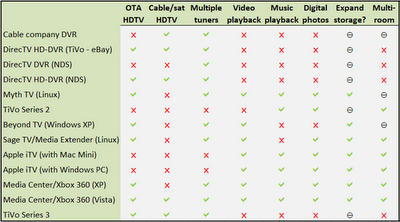 Media overload: The following table lists features available for the most popular digital media systems that are intended for use in the living room and offer TV capabilities. A a green check mark means the feature is available by default; a red X means the feature is completely unavailable; the circle icon indicates the feature may be available but requires additional hardware or an unsupported hack. For more details, see "Who's got the best seat in the digital living room?"
Media overload: The following table lists features available for the most popular digital media systems that are intended for use in the living room and offer TV capabilities. A a green check mark means the feature is available by default; a red X means the feature is completely unavailable; the circle icon indicates the feature may be available but requires additional hardware or an unsupported hack. For more details, see "Who's got the best seat in the digital living room?" From ZDnet:
"A lot of hardware and software companies, including Microsoft, are betting big bucks that they can take over the living room and be your hub for digital media. So who are the contenders? I've been looking at the digital media landscape for the past year and have narrowed the list to a handful of big players.
The options I've chosen to highlight in the accompanying feature table are all built around the television set and digital video recorder (DVR) capabilities. The high end includes support for high-definition TV.
This isn't a complete survey by any means. If you just want to add digital music playback capabilities to the audio receiver in your living room, you have other options that I don't discuss here. You can pick up a docking station for your iPod and plug it into the receiver, or use a box like the Squeezebox or D-Link MediaLounge to stream media files from a networked computer. And I deliberately left out some contenders, most notably ReplayTV and Dish Network.
In this post, I'm not considering anything but features. Part 2 in this series will look more closely at costs, which can be substantial. Part 3 will look at some of the intangible issues, including setup, ease of use, expandability, and reliability.
With those caveats out of the way, here's a rundown on the contenders who want to be the hub of digital media in your living room:
Cable company DVRs. These days, every cable company has some sort of digital video recorder. The cable company has some overwhelming advantages, including the ability to deliver a full range of HDTV channels, relatively easy setup, low cost (typically a monthly rental fee and no upfront charge), and low barriers to entry.
TiVo. The introduction of the CableCard-equipped, HD-ready TiVo Series 3 has breathed new life into the one-time leader in DVR technology. Unfortunately, many of the most interesting features from the Series 2 aren't available in the new model, including support for digital music and the ability to record a program on one DVR and play it back in another room.
MythTV. This is the open-source PC solution, which runs on Linux and Mac OS X boxes but not on Windows. It does nearly everything you could want in a digital media hub, but it is not for the faint of heart.
Beyond TV. The best-known third-party alternative to Microsoft's Media Center runs on Windows and has most of its feature set. It's been continually updated and is now up to version 4.4.
Sage TV. Doesn't get the publicity of the other entrants here, but is intriguing for two reasons. First, it's available in Windows and Linux versions. Second, it supports the MediaMVP extender from Hauppauge, which allows you to stream recorded TV to a TV in another room.
Media Center. Microsoft's full-featured digital media solution has been under continual development and improvement since 2002. Windows Vista Media Center has been certified for use with CableCard technology and is also reportedly working with DirecTV on add-in hardware, which will make it the first PC-based solution to offer support for premium HDTV channels. If you have a networked Xbox 360 in the living room (or anywhere else in the house), you can control the Media Center interface and play back any content stored on that PC.
Apple iTV. Apple's official announcement for this upcoming product was literally a few words in a press release about iTunes 7. (I wrote about this technology based on a few third-party reports.) The data in the feature table here is based on those preliminary reports and is subject to change.
The biggest dividing line between the technologies I've listed here is support for premium HDTV channels. Most of the PC-based products can decode over-the-air (OTA) digital channels if you have the right hardware. But the bar is much higher for cable and satellite HDTV. The cable and satellite companies have a built-in edge in that regard; TiVo (with its Series 3) and Microsoft (with its upcoming Vista Media Center) have run the CableLabs gauntlet and earned certification for their hardware.
The other big dividing line between the solutions I've listed here is in offering a unified interface for all types of digital media, including music, video, and photos. As I mentioned earlier, you can use third-party products in an existing living room AV setup to add digital music playback capabilities, but you pay a price in complexity.
Based on the unbroken line of green checkmarks next to its name, it's clear that Microsoft has decided to make its Vista Media Center the ultimate digital media hub. But having a long checklist of features is just the first step. In parts 2 and 3, I'll look at the fixed and monthly costs of all these solutions and at how likely they are to appeal to digital media enthusiasts."
No comments:
Post a Comment